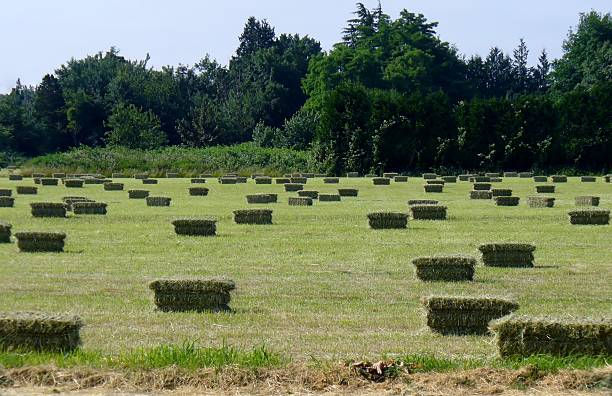Hay As Livestock Feed: Nutritional Benefits of Hay
- Michele Pulis

- Sep 15, 2023
- 3 min read

Freshly baled hay in field...
When it comes to feeding our beloved farm animals, few things are as fundamental as hay. It's the backbone of many livestock diets and provides essential nutrients, fiber, and sustenance for our ‘pasture family’. While there are various ways to process and store hay, square bales remain a popular choice for their ease of handling and individual feeding benefits. At Haystack Homestead we sometimes put a round bale in the pasture in the winter when grazing is somewhat sparce. Most of the hay we feed though is processed into small square bales. These are much easier to transport, stack, store, and move to individual stalls. In this blog post, we will explore the importance of hay as a primary feed for farm animals and how square bales fit perfectly into the equation.
The Nutritional Powerhouse
Hay is often referred to as the "gold standard" in livestock nutrition, and for good reason. It offers a balanced combination of fiber, protein, vitamins, and minerals that are crucial for the health and well-being of farm animals. Let's break down some of the key nutritional benefits:
Fiber: High-fiber content in hay aids in proper digestion. It keeps the digestive tract healthy and prevents issues like colic in horses and bloat in cattle.
Protein: While not as protein-rich as some other feeds, hay still provides essential amino acids necessary for muscle growth and overall health.
Vitamins and Minerals: Hay contains vitamins A, D, and E, as well as minerals like calcium and phosphorus. These nutrients are essential for bone health, reproduction, and immune system function.
Weight Maintenance: Properly balanced hay helps farm animals maintain a healthy weight. It's a particularly important consideration for equine like horses (and especially donkeys) as obesity can lead to various health problems.
Square Bales: Convenience and Precision
Square bales are a popular choice among farmers for several reasons, including:
Ease of Handling: Square bales are compact and easy to stack, making them convenient for storage and transport. This makes them an excellent choice for farmers with limited storage space.
Individual Feeding: Square bales allow for precise portion control. This is especially important when feeding animals in stalls or pens, ensuring each animal receives its required portion without overfeeding.
Reduced Waste: The compact nature of square bales helps reduce waste. Unlike round bales, which can be challenging to manage for smaller herds, square bales are less likely to become contaminated by dirt or moisture.
Quality Assurance: Square bales are easier to inspect for quality, allowing farmers to identify and remove any moldy or spoiled portions before feeding them to their animals.
Varieties of Hay
Farmers have several types of hay to choose from, including:
Timothy Hay: Known for its high fiber content, timothy hay is an excellent choice for maintaining digestive health in rabbits, guinea pigs, and horses.
Alfalfa Hay: Alfalfa hay is richer in protein and calcium, making it suitable for young, growing animals and pregnant or lactating females.
Orchard Grass Hay: This sweet-smelling hay is well-liked by many animals, including rabbits, guinea pigs, and horses.
Meadow Hay: A mix of grasses and plants found in natural meadows, this hay provides a variety of nutrients and is popular among many types of livestock.
Conclusion
Hay is the backbone of livestock nutrition, providing farm animals with essential nutrients and fiber for optimal health. Square bales offer a convenient way to store and distribute hay, making it easier for farmers to manage their feed programs, reduce waste, and ensure each animal receives the proper portion.
So, whether you're caring for horses, cattle, goats, or any other farm animals, remember that hay is not just feed; it's a vital component of their well-being. By employing square bales for precision feeding, you're not only ensuring the health of your animals but also contributing to their wellness and happiness on your farm.



Comments